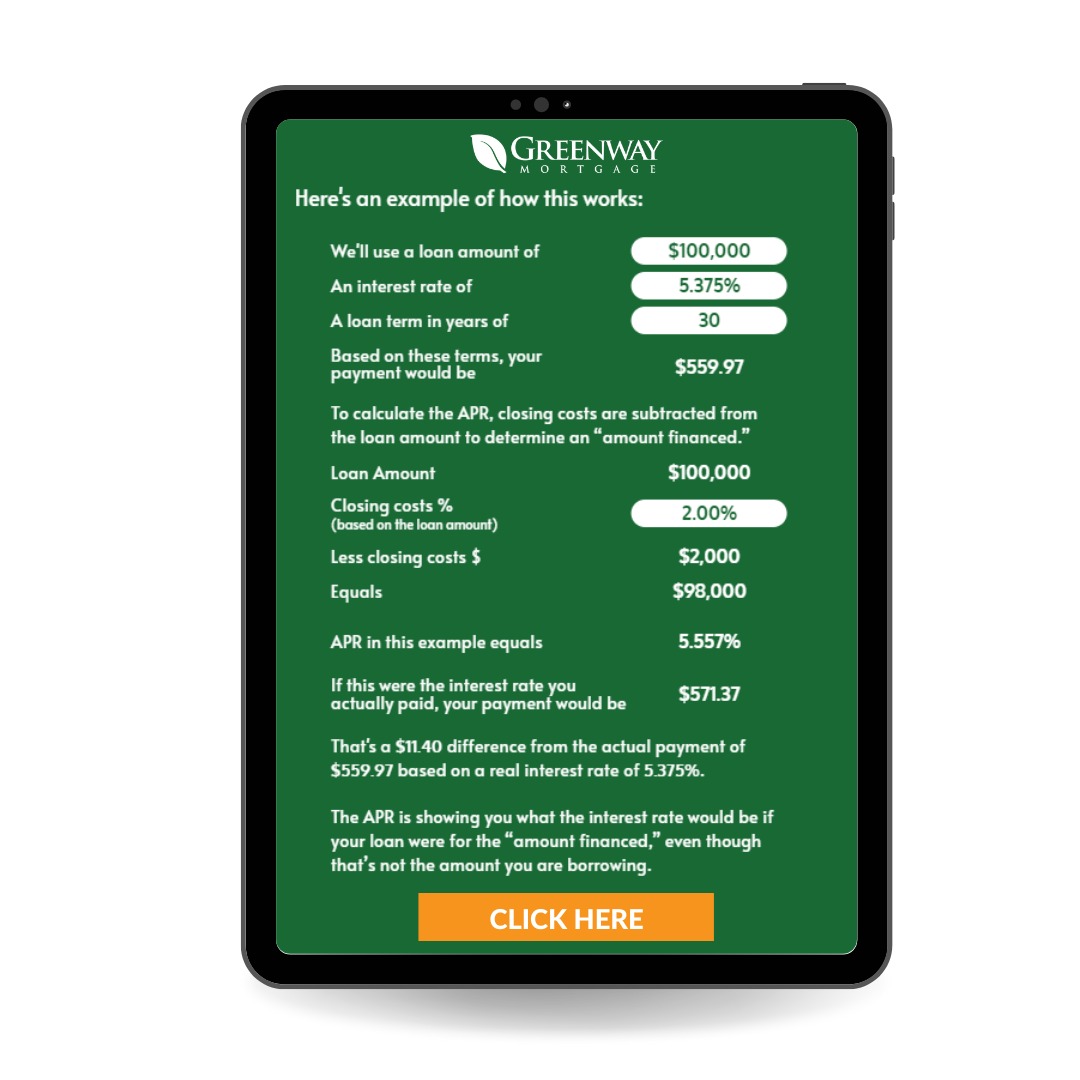

The Annual Percentage Rate (APR) is not the rate you pay. Homebuyers will often believe the lowest annual percentage rate (APR) is the best.
In fact, it's more important for buyers to weigh options against their personal financial situation and the amount of time they plan to have the loan.
Low APRs typically come with the highest cost, and those funds can often be better deployed against larger down payments or, in some instances, paying off high-rate consumer debt.
instances, paying off high-rate consumer debt.
Here's a quick overview of what an APR is and how to calculate the costs and/or savings that accompany a lower one.
What is APR?
APR is not the interest rate that you pay. It’s a government-required calculation intended to show the total cost of borrowing, expressed as an interest rate.
The APR is derived from a formula using these two factors:
- The actual rate and term of your loan
- Certain closing costs that are associated with your loan
Again, it is not the rate you actually pay. Click here to see how APR actually works.
APR is best used as a tool for comparing loans with dissimilar terms. Where APR is lower, associated costs of closing your loan may actually be higher. Keep in mind that the calculation assumes you'll keep your loan for its full term. Few people ever see the 5th year of their home loans these days, much less the 30th.
APR will be lower on a loan where you pay more “points” to lower the interest rate. But if you don’t hold the loan long enough to earn back the points paid up front, that money will be wasted. If APR were calculated for the average amount of time borrowers actually have their loans instead of the full term, it would be higher. Comparisons would be more helpful and less potentially misleading.
Bottom Line:
APR is intended to give you more information about what you're really paying.
Any time you or someone you know has questions about interest rates or any aspect of home financing, please reach out.
The Greenway Team is happy to help! Reach out to us today.

Is the home you want out of reach?
In a time of rising rates and prices, the home you really want may be out of reach with the typical fixed-rate loan.
But stretching further isn't really much of a stretch at all with an ARM—an adjustable rate mortgage. If you're skeptical, be assured they've changed for the better over the years.
Here's How Adjustable Rate Mortgages Work:
-
Most ARMs are hybrid. They are fixed for a period of time, usually 5, 7 or 10 years, before being subject to adjustments.
-
During the initial period, rates (and monthly payments) will typically be lower than those offered by fixed-rate loans.
-
Interest rate caps can keep future adjustments predictable.
For example, a 30-year loan of $300,000 could have a payment savings of over $183 per month with an interest rate that's 1% lower. A loan such as a 5/1 ARM may offer this kind of payment savings.
Is An ARM Right For You?
ARMs aren't for everyone, but hybrid ARM loans can offer years of fixed principal and interest payments.
They work especially well if you plan to sell or refinance before the adjustments occur.
Click below to estimate the payment and savings a hybrid ARM can offer, as well as income required to qualify.
If higher rates and prices are keeping you from the home you really want, it is worth a look to see the difference an ARM loan may provide.
Private Mortgage Insurance What Is It and When Can You Cancel PMI?

If you’ve purchased your home with a down payment lower than 20% of the purchase price, you’re likely paying each month for private mortgage insurance (PMI).
We’ve got all the details on PMI, why you need it, how it’s paid, when you can cancel, and more.
What Exactly is Private Mortgage Insurance?
Private Mortgage Insurance, also called PMI, is a type of insurance you may be required to pay for if you have a conventional loan. PMI protects the lender if you stop making payments on the mortgage loan.
PMI is not to be confused with Homeowner’s Insurance, which is required and protects the physical home and property.
When is Private Mortgage Insurance Required?
PMI is required when a borrower has a conventional loan and makes a down payment of less than 20 percent on the price of the home, they are buying. However, if a borrower puts down more than 20 percent, PMI is not required.
Take into consideration the same thing for a home refinance. If you refinance with a conventional loan and your equity is less than 20 percent of the value of the home, PMI is usually required. Speak with your lender for more information.
How Do You Pay for Private Mortgage Insurance?
In most cases, mortgage lenders will roll PMI into your monthly mortgage payment as a monthly premium. Other times, PMI can be paid for as a one-time up-front premium which is paid at closing. Your loan estimate and closing disclosure documents will specify the amount of your Private Mortgage Insurance.
When Can You Cancel PMI?
The good news is that you will not have to pay private mortgage insurance forever. It can be canceled once your loan-to-value (LTV) falls below 80 percent of the home’s original appraised value. Sometimes this can happen sooner if your home’s value appreciates before then.
How Do I Cancel My PMI?
As we noted above, you may be eligible to cancel your PRMI when your equity reaches 20 percent. Your Private Mortgage Insurance will fall off automatically once you reach 22 percent equity. However, if you’re at 80 percent equity, want to be proactive, and save some money, you can reach out to your mortgage lender and request that they cancel your PMI. Your lender will advise on the necessary steps to take to cancel PMI.
If you’re not quite at 80 percent equity in your home, continue to make your mortgage payments on time each month.
Mortgage Tip: Have extra cash for a month? If so, put that money toward your principal to build your equity even faster. Be sure to make a note to your lender that you want the extra payment to go towards your principal balance and not your next mortgage payment. This can easily get confused or overlooked otherwise.
Is The Time Up on Your PMI? It’s Time to Find Out!
Use our PMI Removal Calculator to find out if you’re eligible to drop PMI and, if not, how much further you may need to go before you get to that point.
If you have any questions along the way about canceling PMI or home financing in general, please reach out. We are happy to help.

If you've been following the news lately, you've heard about rising inflation. Today, inflation is at a 40-year high. According to the National Association of Home Builders (NAHB):
“Consumer prices accelerated again in May as shelter, energy and food prices continued to surge at the fastest pace in decades. This marked the third straight month for inflation above an 8% rate and was the largest year-over-year gain since December 1981.”
As prices go up for gas, groceries and more, your wallet is likely feeling the impact. If you're thinking about purchasing a home this year you may have hesitated a time or two. Is now the right now? That depends on your current situation. Homeownership is a great hedge against the impact of rising inflation. Here's how homeownership can help you combat rising costs.
Are you protected?
With all the talk of rising prices, there's one tool that has proven time and again to serve as a hedge—or protection—against inflation:
Owning a Home.
Real estate prices have been rising along with everything else. There are the usual factors of supply and demand, but inflation itself is impacting values too. Given rising labor and material expenses, it now costs more to build a home or replace one that's been damaged. That contributes to making existing properties more valuable too.
Here are some ways homeownership serves as a hedge against inflation.
-
As your home appreciates in value, you gain more in equity, yet your costs remain relatively stable.
-
For most homeowners, the increases in home values far outpace the increased costs of other goods. For example, you may be spending $4,000 for gas this year instead of the $2,000 it cost last year. Yet if you own a home that was worth $300,000 last year, it may be worth $360,000 this year as values are up more than 20% nationally.
-
Increases in value are not money in your wallet, though you may be able to access cash through a home equity loan or line of credit. Otherwise, you can realize the benefits when you sell or refinance your home.
-
Many owners reduce their housing costs through tax deductions. (Always consult with a tax advisor.)
-
Homeowners often avoid capital gain taxes, and even for real estate investors, taxes on gains are deferred until sale.
If you're not yet hedging your purchasing power with a home of your own, there may still be time to act before costs increase further.
Please reach out if we can assist you or someone you know.

Have you ever played Chess, the game of life, before? Chess requires you to plan and think about strategy, it’s a game about making strong moves and sticking by them. Every decision made has an impact on the rest of your game. Well, the same can be said about buying a home; planning and thinking about strategy ahead of time is extremely important from the very beginning stages.
Economists expect the 2022 housing market to be a tad gentler to home buyers. However, the homeownership dream will still require strategy and stamina. Have no fear! We’ve got a few good tips to ensure your home buying plan is as strong as possible when you begin your home search.
#1: Best Opening Move is Getting Preapproved
Getting pre-approved by a lender should always be step number one. Getting an upfront loan approval will help you beat out the competition, negotiate with power and let you know how much you can afford.
Benefits of Getting Pre-Approved
-
A pre-approval tells you the maximum amount you are qualified to borrower.
-
A pre-approval allows you to look for a home with greater confidence and it demonstrates to the seller that you’re a serious buyer.
-
A pre-approval letter signals that you’re a serious, interested buyer.
#2 It’s a Team Game, Not A Single-Player Experience
Every step you take to create your game-plan strategy as a buyer is important especially in today’s hot housing market. Why? Mortgage interest rates are still low by historical standards; however, they're increasing. Prices are going up and there is a limited supply of homes for sale. Don’t let this stop your search for your dream home.
What do we mean by “It’s a team game”? That means leaning on expert guidance as you plan every move is very important. Having a team of professionals like your trusted Real Estate Agent and Greenway Mortgage Loan Officer is important to ensure you make the right moves every step of the way.
#3 Set Realistic Expectations, Know What You Want and Can Offer
-
The best way to avoid getting discouraged is to manage your expectations.
-
Consider homes that need cosmetic updates.
-
Be prepared for bidding wars. Before shopping around, know the maximum offer you’re willing to make.
-
Target houses that are priced under what you’re pre-approved to buy so you have room to negotiate.
-
Decide what you need and what you can live without in a home.
-
Consider a fixer upper. You’ll likely face less competition!
-
Be vigilant and be patient.
The Housing Market in 2022 – What to Expect:
-
Home prices are expected to increase at a slower pace than in 2021. The National Association of Realtors projects home prices will increase just 2.8% in 2022, far less than the estimated 14.7% gain in 2021.
-
Mortgage rates will likely rise in 2022. However, even if they go up, they will still be low. The National Association of Realtors projects the 30-year fixed mortgage rate to rise to 3.7% in coming months. The Mortgage Bankers Association projects an increase to 4%, while Fannie Mae and Freddie Mac project the 30-year fixed will average 3.3% and 3.5%, respectively.
Bottom Line:
If you’re serious about buying a home in 2022, contact a Greenway Mortgage Loan Officer to get pre-approved first or click here to get started.
Remember, getting a pre-approval letter isn’t just good strategy, it can a game changer! It allows you to get a full understanding of what you can afford, and it signals to sellers that you’re serious.
Connect with your trusted real estate agent and loan officer so ensure you’re playing chess and being strategic throughout the entire home buying process.







.jpg)